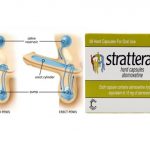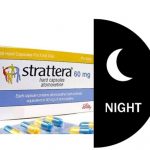Does Strattera Help With Anxiety?

An anxiety disorder is a type of mental health condition. If you have an anxiety disorder, you may respond to certain things and situations with fear and dread. You may also experience physical signs of anxiety, such as a pounding heart and sweating.
Anxiety statistics worldwide show that anxiety disorders are common across the globe. According to the World Health Organization, 3.6 percent or about 264 million individuals worldwide have an anxiety disorder. Additionally, 4.6 percent of females and 2.6 percent of males globally are affected by anxiety.
It’s normal to have some anxiety. You may feel anxious or nervous if you have to tackle a problem at work, go to an interview, take a test, or make an important decision. And anxiety can even be beneficial. For example, anxiety helps us notice dangerous situations and focuses our attention, so we stay safe.
But an anxiety disorder goes beyond the regular nervousness and slight fear you may feel from time to time. An anxiety disorder happens when:
• Anxiety interferes with your ability to function.
• You often overreact when something triggers your emotions.
• You can’t control your responses to situations.
Anxiety disorders can make it difficult to get through the day. Fortunately, there are several effective treatments for anxiety disorders. Anxiety disorders can be treated with medication, psychotherapy, or a combination of the two. Some people who have a mild anxiety disorder, or a fear of something they can easily avoid, decide to live with the condition and do not seek treatment.
What is Strattera?
Strattera is a brand of atomoxetine, a prescription medication used to treat attention-deficit hyperactivity disorder (ADHD) in children, teenagers, and adults. It belongs to the group of medicines called selective norepinephrine reuptake inhibitors (SNRIs). Drug treatment is the most effective treatment for ADHD as a neurodevelopmental disorder.
Strattera works in the brain to increase attention and decrease restlessness in people who are hyperactive, have problems with concentration, or are easily distracted. This medicine may be used as part of a treatment program that includes social, educational, and psychological treatment.
Strattera is available in 10 mg, 18 mg, 25 mg, 40 mg, 60 mg, 80 mg, and 100 mg capsules.
How should I take Strattera?
Strattera comes as a capsule to take by mouth. It is usually taken either once a day in the morning, or twice a day in the morning and late afternoon or early evening. Strattera may be taken with or without food. Take Strattera at around the same time(s) every day.
The typical dosing of Strattera is as follows:
Adults and children over 70 kg (154 lbs) in body weight: The typical starting dose is 40 mg by mouth per day. It can be given once in the morning or as divided doses in the morning and late afternoon/early evening. After 3 days, your provider will raise your dose to 80 mg per day. The dose can be adjusted up to a maximum daily dose of 100 mg.
Children 70 kg (154 lbs) or less in body weight: The total daily dose will depend on the child’s weight and can be given once in the morning or as divided doses in the morning and late afternoon/early evening. The typical starting dose is 0.5 mg/kg by mouth per day and then raised to 1.2 mg/kg per day after 3 days. The dose can be adjusted up to a maximum of 1.4 mg/kg per day (or 100 mg per day, whichever is less).
Children less than 6 years old: Atomoxetine (Strattera) is not recommended for this age group. Ask your child’s provider for an alternative medication for your child.
Follow the directions on your prescription label carefully, and ask your doctor or pharmacist to explain any part you do not understand. Take Strattera exactly as directed. Do not take more or less of it or take it more often than prescribed by your doctor.
Swallow Strattera capsules whole; do not open, chew, or crush them. If a capsule is accidentally broken or opened, wash away the loose powder with water right away. Try not to touch the powder and be especially careful not to get the powder in your eyes. If you do get powder in your eyes, rinse them with water right away and call your doctor.
Your doctor will probably start you on a low dose of Strattera and increase your dose after at least 3 days. Your doctor may increase your dose again after 2–4 weeks. You may notice an improvement in your symptoms during the first week of your treatment, but it may take up to one month for you to feel the full benefit of Strattera.
Strattera may help to control the symptoms of ADHD but will not cure the condition. Continue to take atomoxetine even if you feel well. Do not stop taking atomoxetine without talking to your doctor.
Does Strattera for anxiety and depression in adults?
Yes, Strattera is sometimes prescribed off-label by doctors for treating generalized anxiety disorder, because of its ability to help patients relax, and manage mood swings.
Strattera has also shown promising results in the treatment of other anxiety disorders. As a selective norepinephrine reuptake inhibitor (NRIs), Strattera (atomoxetine) may treat both ADHD and social anxiety symptoms.
However, Strattera has not been shown to be an effective medication for the management of depression even though it works by changing the way your brain absorbs the chemical norepinephrine as well as how that chemical acts in your body. Norepinephrine affects your overall mood.
What are the other side effects of Strattera?
Common side effects of Strattera include:
• Abdominal pain
• Constipation
• Cough
• Decreased appetite
• Depression
• Dizziness
• Drowsiness
• Dry mouth
• Headache
• Hot flashes
• Increases in blood pressure (BP; 15-20 mm Hg or greater) and heart rate (HR; 20 beats/minute or greater)
• Indigestion/heartburn
• Irritability
• Itching
• Menstrual disorder/increased menstrual cramps
• Mood swings
• Nausea
• Sexual side effects (impotence, loss of interest in sex, or trouble having an orgasm)
• Sinus headache
• Skin rash (dermatitis)
• Trouble sleeping (insomnia)
• Upset stomach
• Urinary hesitation or retention
• Vomiting
• Weight loss
Serious side effects of atomoxetine include:
• Depression and depressed mood, anxiety
• Difficulty urinating
• Excess sweating
• Fainting
• Lethargy
• Male pelvic pain, urinary hesitation, or retention in children and adolescents
• Muscle wasting (rhabdomyolysis)
• Numbness or tingling
• QT prolongation, fainting
• Raynaud’s phenomenon
• Reduced sense of touch, numbness, and tingling in children and adolescents, sensory disturbances, tics
• Unusually fast or irregular heartbeat
Strattera may cause other side effects. Call your doctor if you have any unusual problems while taking this medication.
If you experience a serious side effect, you or your doctor may send a report to the Food and Drug Administration’s (FDA) MedWatch Adverse Event Reporting program online (http://www.fda.gov/Safety/MedWatch) or by phone (1-800-332-1088).





